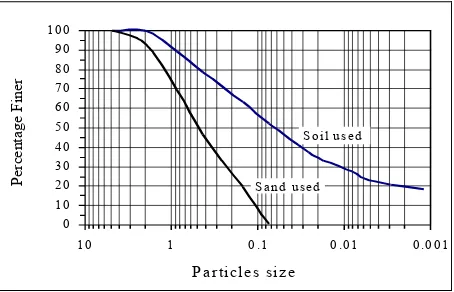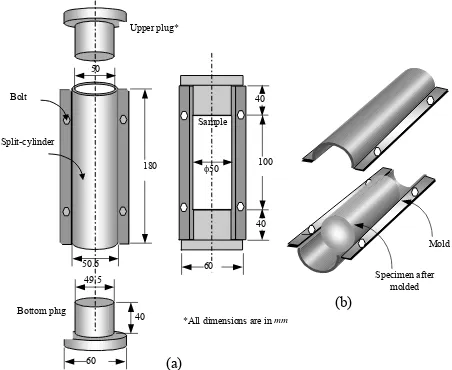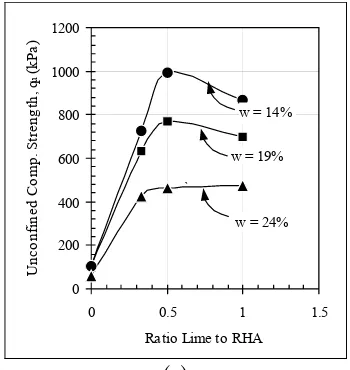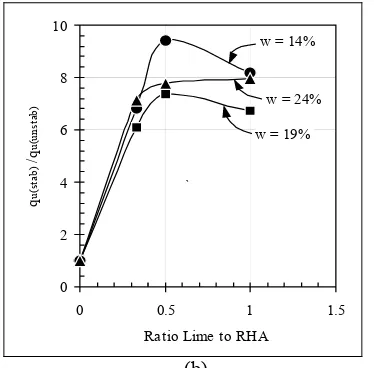THE INFLUENCE OF MOLDING WATER CONTENT AND LIME
CONTENT ON THE STRENGTH OF STABILIZED SOIL WITH
LIME AND RICE HUSK ASH
Agus Setyo Muntohar
Senior Lecturer, Department of Civil Engineering, Muhammadiyah University of Yogyakarta Email: [email protected]
ABSTRACT
The strength gain of stabilized soils is not only influenced by the type and proportion of the stabilizers and its curing time, but also by the water content needed to maintain the reaction. The reaction of lime – RHA with soil is pozzolanic. Hence, the process will be subjected greatly by the amount of water to react with admixtures and the proportion of the stabilizer. This paper presents the result of a laboratory study on the unconfined compressive strength (UCS) of soils stabilized with lime and RHA, compacted at the OMC, and at the dry and wet side of OMC. The amount of lime required for stabilization (LRS) is determined by Eades and Grim's Method. The results showed that the water content determines the UCS characteristics of unstabilized and stabilized soils. The UCS of stabilized soils decreased with increasing molding water content, but it is still higher than of the un-stabilized soils. In general, higher lime content results to a higher UCS. The maximum strength of the stabilized soil is attained at lime/RHA ratio of 1/2. The UCS of the stabilized soil increased significantly about 7 – 9 times to the un-stabilized UCS.
Keywords: soil stabilization, molded water content, lime, rice husk ash, unconfined compressive strength.
INTRODUCTION
Utilization of lime, cement, and or fly ash is widely used to chemically transforming unstable soils into structurally sound foundation. In clay-bearing soils, these stabilizers induce a textural change in greater ease of compaction and handling as well as moderate improvements in the resulting strength. Rice husk is a major agricultural by-product obtained from rice field crop. The existence is abundance all over the tropical countries, such as Indonesia, Thailand, Philippines, Brazil, and many others. Generally, it is considered a valueless product of rice milling processes.
Review of Soil Stabilization Using Rice Husk Ash
Very little information has been published on the engineering properties of pozzolanic stabilized materials using RHA as additive. Lazaro and Moh [1] examined the use of RHA in combination with lime for clay stabilization. They concluded that the addition of RHA in combination with lime to both Thai soils and Philippine soils could not produce any
Note: Discussion is expected before June, 1st 2005. The proper discussion will be published in “Dimensi Teknik Sipil” volume 7, number 2, September 2005.
significant increase in strength as compared to the use of lime alone. Compared to the equivalent strength values, the amount of lime in a lime-ash-soil mixture is significantly less than that required in a lime-soil system.
Rahman [2] studied the effects of various cement-RHA proportions on the geotechnical properties of lateritic soils. The research had taken note that the cement-RHA stabilized lateritic soils could be used in highway construction. The author recommended a mix proportion 6% RHA – 6% cement and 6% RHA – 3 % cement for base and sub-base materials, respectively.
addition of RHA. Addition of RHA, furthermore, needs a lesser amount of cement to achieve a given strength. In general, the study shows that the proportions of 6-8% cement and 10-15% RHA contribute very significant enhancement of some engineering properties. Reduction in plasticity, and increase of the strength and resistance to immersion indicate an improvement.
Muntohar [6] investigated that the addition of RHA at the 6% lime content, the optimum amount, decreased the liquid limits while the plastics limits increased. As a consequence, the plasticity indices and swelling potential decreased with the addition of the additives. On other hand, addition of RHA increases the optimum moisture content (OMC) and decreases the maximum dry density (MDD). Further more the research confirmed that mixtures of 6% lime and RHA increase significantly the CBR values and the shear strength of soils. Balasu-bramaniam et. al [7] studied the behavior of soft Bangkok clay treated with some combination additives such as cement, lime, fly ash, and RHA. The addition of fly ash and RHA exhibits ductile behavior associated with higher strain and low strength.
Research conducted by Budi et. al [8] on the soil stabilization using lime and RHA showed that soil strength increase up to 400% by addition of 24% of lime. The strength decreased to 300% when that amount of lime (24%) is replaced by 60% of lime. The strength gain is observed for 28 days of curing, however it was observed that the optimum strength gain is achieved at 14 days of curing. In general, all the specimens tested are prepared on their optimum moisture content. A mixtures of 40% lime and 60% RHA improve the properties of expansive clay soils including swelling potential which is decreasing below 1%.
Needs for the study
Almost all the specimens used in the studies conducted in the references cited are prepared on their OMC or near OMC. Considering the factors influenced during stabilization, the strength gain of stabilized soils is not only influenced by the stabilizers and curing time but also the water content needed to maintain the reaction. Since the reaction of the lime – RHA and soils is pozzolanic reaction, the process will be much influenced by presences of the water mixed with the admixtures. This hypothesis is similar as observed by Horpi-bulsuk et. al [9], that the strength development of cement stabilized clay was affected by clay type, water content and cement content.
In this research, a laboratory test is carried out to investigate the influences of molded water content, at OMC and below OMC, on the strength of soils stabilized with lime and RHA. The evaluation of unconfined compressive strength of the stabilized soils is the main test in this research. Little [10] and AustStab [11] explained that the unconfined com-pressive strength is simple and useful to correlate with bearing ratio and other engineering properties of stabilized soils.
TEST MATERIALS
Soils Used
As for the highway construction purpose, the soils were commonly filled or mixed with sand. On the basis of this illustration, the soils in this study is mixed with a certain amount of sand. The soil used was taken from farming area at Godean, Yogya-karta, at the depth of 40-80 cm below the ground surface. The soil was identified as organic soil that consists of 20% clay particles, 33% silt, and 47% fine sand. The consistency limits of the soil were 41%, 25%, and 16% respectively for liquid limit (LL), plastic limit (PL) and plasticity index (PI). As referred to the Unified Soils Classification System, the soil can be classified as ML or OL. The ratio of LLoven-dried and LLnot-dried was found lower than 0.75,
so the soil could be categorized as sandy organic-clay, which has low plasticity. The particle size distribution (PSD) of the soil used is illustrated in Figure 1.
Figure 1. PSD of the soil and sand used in the study
Sand
The sand used in this study was a deposit originated from Mount Merapi. The sand is commonly used as construction materials in Yogyakarta. Its PSD was also shown in Figure 1. The coefficient of uniformity (Cu) and coefficient of curvature (Cc) of the sand are
Lime and rice husk ash
In this research, hydrated lime was used as the stabilizing agent. The major chemical constituent of the lime is calcium hydroxides [Ca(OH)2]. To reduce
the carbonation effect due to humidity, the lime is kept in the airtight plastic drum. The other stabilizing material is rice husk ash, RHA. For this research, merely the grey color ashes were chosen. An amount of 5kg RHA was then ground by 40 mild steel balls in the Los Angeles abrasion machine. The grinding took 3 hours to equal 5000 revolutions. This period produces suitable fineness and proper surface area of RHA respectively about 12.4% and 25 mm2/g. The ground RHA is then transferred into
plastic bag and stored in the airtight container at room temperature to prevent atmospheric humidity absorption.
Tests Scheme
Mixtures Proportion
According to preliminary tests, the amount of 30% sand is an optimum proportion to enhance the dry density. The OMC and MDD of the soil-sand mixture is 19% and 17.4 kN/m3.
The lime required for stabilization (LRS) is determined according to the method developed by Eades and Grim [12]. The test determines the lime-fixation, which is the percentage of lime required to produce a saturated solution of lime in a suspension of clay in water and thereby to satisfy fully ion exchange. The saturation of the suspension is approached by the determination of the pH of solution, which a value of 12.40 indicating saturation. As a result, 5% lime is amount of LRS
for the tested soil. The proportion of lime and RHA mixtures is determined in ratio lime to RHA as 1 : 1, 1 : 2, and 1 : 3. The lime content is varied into LRS
(5%), LRS-3% (2%) and LRS+3% (8%).
Sample Preparation
The unconfined compression test was performed to observe the strength (UCS). Specimens were compacted by static compaction method. The known amount of soil was placed into cylindrical mould (Figure 2). During filling, the materials were tamped gently and uniformly so that the upper plug could be inserted in about 15 mm. The assembled mould was then placed on a hydraulic jack to gently force the upper plug in contact with the barrel of the mould. That was maintained for about 30 seconds before the specimens were dismantled. The dimen-sion of the specimens measured 50 mm in diameter and 100 mm of length. The mass of specimen was determined immediately after preparation and then kept in plastic bag, thus cured for 28 days.
Sample
40 49.5 50.6
60 50
180 100
40
40
φ50
60 Upper plug*
Bottom plug Bolt
Split-cylinder
Specimen after molded
Mold
(a)
(b)
*All dimensions are in mm
Figure 2. Static compaction mold for preparing UCS sample (a) the dimension of mold (b) the specimen after molded.
Unconfined compressive strength test
After the curing periods and before testing, the mass and dimension of the specimens were recorded. The specimen was placed centrally on the lower platen of the compression testing machine. The force was applied with a controlled strain rate of approxi-mately 1 mm/minute. The force was recorded during the test until the specimen yielded.
RESULT AND DISCUSSION
Effect of molded water content
Unconfined compressive strength of the lime-RHA stabilized and unstabilized soils at different molding water content is shown in Figure 3. On the basis of the figure, the unconfined compressive strength of unstabilized soil achieved maximum strength at molding water content 19% or at optimum moisture content (OMC). Reducing and adding water content decreases the UCS values compared to UCS of molding water content at OMC. This characteristics is in agreement with compaction characteristics in which the unit weight (dry density) of the compacted soil decreases when the soil was compacted at dry side and wet side of optimum moisture content. The UCS of unstabilized soil indicated that the unconfined compressive strength is influenced by the density or unit weight of the compacted soil. Seņol et. al [13] elaborated that the maximum strength will be obtained at a specific water content, close to the optimum moisture content.
contrary to the theory of soil-lime reaction, which needs more water to maintain the chemical reaction to produce pozzolanic materials.
0
Molded water content, w (%)
U
Molded water content, w (%)
U
Molded water content, w (%)
U
Figure 3. UCS of lime-RHA stabilized and unstabilized soil at different molding water content (a) for lime content LRS-3%, (b) LRS (c) LRS+3%.
The UCS-characteristics of stabilized soil may be explained by the theory of soil particles and fabric orientation. The stabilized-soil with lime and rice husk ash yield a more random orientation of the soil
particles, which gives a more dispersed structure when compacted at lower water content. As a result, the particles are closer and yielding a more compact structure and attributed to increase in strength. This phenomenon is also observed by Muntohar [14] by using SEM images. Increasing water content will result in more parallel orientation of soil fabrics and the added water dilutes the soil solid whose has a weaker structure and affect to decrease the soil strength. Muntohar [14] shows that the stabilized soil with lime and rice husk ash will has higher strength beyond of 28 days of curing subjected to higher molding water content.
Effect of lime-rice husk ratio
Figure 4 shows the unconfined compressive strength of stabilized soil with varies of lime and RHA ratio at different water content. The soil strength raise significantly 500% (600% when it was blended with lime) RHA ratio of 1:3 for all molding water content. The figure depicts obviously, for molding water content of w = 14% and w = 19%, that the lime and RHA ratio of 1:2 attained maximum strength gain as 995 kPa and 767 kPa respectively for w = 14% and w = 19%. Further reducing the RHA content, for lime – RHA ratio of 1:1, tends to decrease the unconfined compressive strength of the stabilized soils to become 865 kPa and 697 kPa respectively for w = 14% and w = 19%. However, a different characteristics was observed at higher water content (w = 24%) in which the unconfined compressive strength increase margi-nally up to the lime – RHA ratio of 1:1. The result is in accordance with theory of lime-soil reaction of which need additional water to establish a modify-cation and stabilization process. Figure 4b indicates that, in general, the unconfined compressive strength of the stabilized soil increase significantly in range of 7 – 9 times compared to its unstabilized condition.
Ratio Lime to RHA
0
Ratio Lime to RHA
q
Figure 4. Unconfined compressive strength of stabilized soil for lime content at LRS.
CONCLUSION
A series of laboratory test have been successfully carried out. It can be concluded as follows:
1. The UCS of unstabilized soil is affected by the density or unit weight of the compacted soil and the molded-moisture content, which the strength-water content curve follows, similar with the compaction curve.
2. The strength of the stabilized soil decreases with increase in molding water content, but it is still higher than of un-stabilized soil.
3. A higher lime content results in a higher strength.
4. In general, the maximum strength of the stabilized soil is attained at lime-RHA ratio of 1:2. The unconfined compressive strength of the stabilized soil increase significantly in range of 7–9 times compared to its unstabilized condition.
Acknowledgement
The author is grateful to M. Amin Rais, an undergraduate student, who has done some labo-ratory test during the research carried out. Acknow-ledgement also goes to Head of Geotechnical Labo-ratory of Muhammadiyah University of Yogyakarta.
REFERENCES
1. Lazaro, R.C., and Moh, Z.C., Stabilisation of deltaic clays with lime-rice husk ash admixtures, Proceeding Second Southeast
Asian Conference on Soil Engineering,
Singapore, 1970, pp. 215 – 223.
2. Rahman, M.A., Effect of cement-rice husk ash mixtures on geotechnical properties of lateritic soils”, Journal of Soils and
Foun-dations, JSSMF, Vol. 27 (2), 1987, pp.
61-65.
3. Ali, F.H., Adnan, A., and Choy, C.K., Geo-technical properties of a chemically stabili-sed soil from Malaysia with rice husk ash as an additive, Geotechnical and Geological
Engineering, Vol. 10, 1992a, pp. 117-134.
4. Ali, F.H., Adnan, A., and Choy, C.K., Use of rice husk ash to enhance lime treatment of soil, Canadian Geotechnical Journal, Vol. 29, 1992b, pp. 843-852.
5. Basha, E.A., Hashim, R., and Muntohar, A.S., Stabilization of clay and residual soils using cement-rice husk mixtures, Jurnal Teknik Sipil, Vol. 5 No. 1, 2004, pp. 51-66 6. Muntohar, A.S., Utilization of
uncontrolled-burnt rice husk ash in soil improvement,
Dimensi Teknik Sipil, Vol. 4 (2), 2002, pp.
100-105.
7. Balasubramaniam A.S., Lin D.G., Acharya S.S.S., and Kamruzzaman, A.H.M., Behavi-our of soft Bangkok clay treated with addi-tives, Proceeding of 11th Asian Regional
Conference on Soil Mechanic and
Geotech-nical Engineering, Vol. 1, Seoul, 1999, pp.
11-14.
8. Budi, G.S., Ariwibowo, D.S., and Jaya, A.T., Pengaruh pencampuran abu sekam padi dan kapur untuk stabilisasi tanah ekspan-sif, Dimensi Teknik Sipil, Vol. 4 (2), 2002, pp. 94-99.
9. Horpibulsuk, S., Miura, N., and Nagaraj, T., Assessment of strength development in cement-admixed high water content clays with Abrams’ law as a basis, Geotechnique, Vol. 53 (4), 2003, pp. 439-444.
10. Little, D. N., Evaluation of Structural Pro-perties of Lime Stabilized Soils and Aggre-gates: Volume 3: Mixture Design and
Testing Protocol For Lime Stabilized Soils,
National Lime Association, 2000.
11. AustStab, Lime Stabilisation Practice, AustStab Technical Note, No.1 May 2002, NSW, Australia.
12. Eades, J.L and Grim, R.E., A Quick test to determine lime requirement of lime stabili-zation, Highway Research Record 139, HRB, National Research Council, 1966, pp. 61-72.
13. Seņol, A., Bin-Shafique, M.S., Edil, T.B., and Benson, C.H., Use of Class C Fly Ash
For Stabilization of Soft Subgrade, Paper
Presented at Fifth International Congress on Advances in Civil Engineering, 25-27 September 2002, Istanbul Technical Uni-versity, Istanbul, Turkey.



